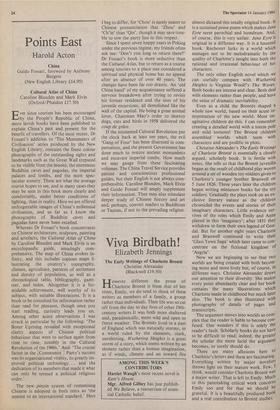Points East
Harold Acton
China Guido Fossati, foreword by Anthony Burgess (New English Library £14.95)
Cultural Atlas of China Caroline Blunden and Mark Elvin (Oxford/Phaidon £17.50)
Ever since tourism has been encouraged by the People's Republic of China, more lavish books have been published to explain China's past and present for the benefit of travellers. Of the most recent, Dr Fossati's addition to 'The Monuments of Civilisation' series produced by the New English Library, contains the finest colour photographs of the outstanding sights and landmarks such as the Great Wall (reputed to be visible from the moon), the enormous Buddhist caves and pagodas, the imperial palaces and tombs, and the most spec- tacular scenery. These are what the average tourist hopes to see, and in many cases they may be seen in this book more clearly and comfortably, under better conditions of lighting, than in reality. Here we are offered unforgettable images of China's millennial civilisation, and so far as I know the photographs of Buddhist caves and pagodas have never been excelled.
Whereas Dr Fossati's book concentrates on Chinese architecture, sculpture, painting and artefacts, the Cultural Atlas of China by Caroline Blunden and Mark Elvin is an encyclopaedic guide, amazingly com- prehensive. The map of China evokes in- finity, and this includes copious maps il- lustrating the country's topography, climate, agriculture, patterns of settlement and density of population, as well as a chronological table, bibliography, gazet- teer, and index. Altogether it is a for- midable achievement, well worthy of its subject, with suitable illustrations. It is a book to be consulted for information rather than read for pleasure, though once you start reading, curiosity leads you on. Among other acute observations I was struck in particular by the following: 'The Boxer Uprising revealed with exceptional clarity aspects of Chinese political behaviour that were to surface again from time to time, notably in the Cultural Revolution of the 1960s.' And: 'The crucial factor in the [Communist ] Party's success was its organisational vitality, its greatly im- proved political technology... and the dedication of its members that made it what can only be termed a political religious order.'
The new pinyin system of romanising Chinese is adopted in both texts as 'the nearest to an international standard.' Here
I beg to differ, for 'Chou' is surely nearer to Chinese pronunciation that 'Zhou' and 'Ch'in' than 'Qin', though it may save trou- ble to tow the party line in this respect.
Since I spent seven happy years in Peking under the previous regime, my friends often ask me: 'Don't you long to return there?' Dr Fossati's book is more seductive than the Cultural Atlas, but to return as a tourist among tourists to a place one considered a spiritual and physical home has no appeal after an absence of over 40 years. The changes have been far too drastic. An 'old China hand' of my acquaintance suffered a nervous breakdown after trying to revisit his former residence and the sites of his juvenile excursions, all demolished like the wall of the capital. He being a great animal lover, Chairman Mao's order to destroy dogs, cats and birds in 1958 delivered the coup de grace.
If the misnamed Cultural Revolution put the clock back at least ten years, the evil `Gang of Four' has been disarmed in com- pensation, and the present Government has done much to restore ancient monuments and excavate imperial tombs. How much we may gauge from these fascinating volumes. The China Travel Service provides patient and conscientious professional guides, but their English is not always com- prehensible. Caroline Blunden, Mark Elvin and Guido Fossati will amply supplement their information. They may also stimulate deeper study of Chinese history and art and, perhaps, convert readers to Buddhism or Taoism, if not to the prevailing religion.






































 Previous page
Previous page